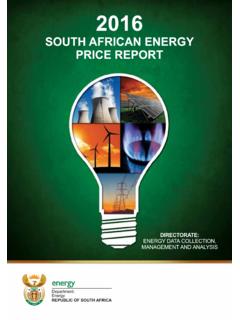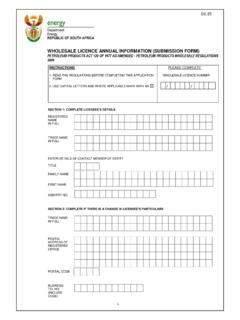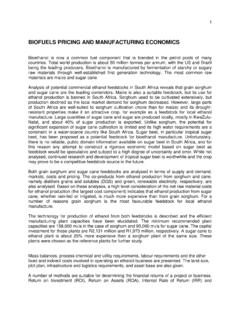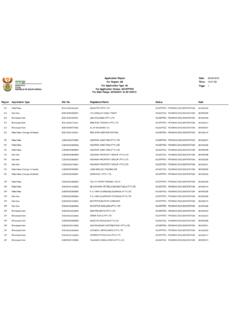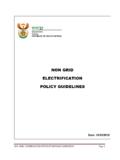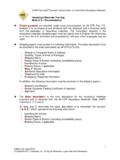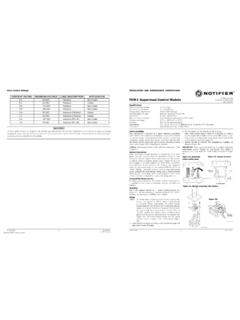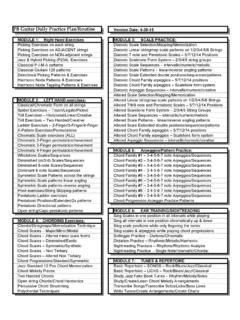Transcription of Module 6: Energy Assessment – Load Inventory
1 Module 6: Energy Assessment load Inventory Building Energy Auditing Course Page Module 6: Energy Assessment load Inventory The Electrical load Inventory Organizations use inventories to keep track of many items. An Inventory of the uses of electricity will help to develop a baseline that will allow you to focus your Energy management efforts upon the areas of greatest opportunity. Making a list or Inventory of all loads in a facility answers two important questions: Where is the electricity used? How much and how fast is electricity used in each category? Often the process of identifying categories of use allows sources of waste to be easily identified, and this often leads to low cost savings opportunities. Identifying the high-consumption loads lets you consider the best savings opportunities first.
2 Because the Inventory also quantifies the demand (or how fast ) associated with each load or group of loads, it is invaluable in further interpretation of the demand profile. Table is a sample load Inventory for an elementary school. Table : Sample load Inventory for Elementary School Elementary School load Inventory Lighting Area Num. kW Total kW Div. Factor Peak kW Hrs Energy kWh 1'X4' 2 lmp Cust. Rm. 6 1 250 144 1 lmp fix. Main Hall 30 1 250 720 2lmp 2 bal. Class Rms 130 1 250 3,413 U tubes Class Rms. 25 1 250 600 2 lmp fix. Class Rms. 9 1 250 216 2 lmp 2bal. Library 25 1 250 656 2 lmp 2bal. Book Rm. 2 25 5 2 lmp fix. Wash Rms. 18 1 250 432 2 lmp fix. Stor. Rms. 3 25 7 15o w. pot Entry 20 1 250 750 U tubes Hallway 21 1 275 370 2 lmp 2bal.
3 Paint Rm 9 25 24 2 lmp 2bal. Paper Supl. 3 25 8 2 lmp 2bal. Film Rm. 9 125 118 2 lmp fix. Lockers 4 1 250 96 150 w. pots Lockers 4 1 250 150 400 w. Gym 9 1 250 1,069 U tubes Gym Stor. 4 125 53 2 lmp 2bal. Gym Office 2 125 26 150 w. IA Janitor Rm. 1 125 19 2 lmp fix. French Rm. 9 1 250 236 60 w. IA's Wash Rms. 2 25 3 60 w. IA's Staff Hall 3 1 250 45 U tubes Staff Rms. 14 1 250 336 Learning Objectives After completing this Module , you will be able to Create an Energy load Inventory , and reconcile it to consumption data Module 6: Energy Assessment load Inventory Page Building Energy Auditing Course 2 lmp 2bal. Staff Rms 10 1 250 263 2 lmp 2bal. Copier Rm 3 125 39 Utubes Copier Rm 1 125 12 60 w.
4 IA Copier Rm 1 125 8 2 lmp 2bal. Music Rm. 12 125 158 U tubes Music Rm. 4 48 18 2 lmp 2bal. U. P. Room 2 150 32 100 w. IA's Mech. Rm. 6 1 250 150 100 w. IA's Boiler Rm 3 25 8 2 lmp strip Boiler Rm. 1 25 2 Totals 10,184 Motors 20 Vent. Fan 1 15 1 250 3,750 Compress. 1 75 30 Fridges 2 460 276 Freezer 1 150 75 Milk Coolers 2 1 300 120 Rooftop Exh - .25 HP 5 1 250 313 Gym H/V Fan 1 2 1 250 500 Gym Circ Pmp - 1 HP 1 1 250 200 Sewage plant aeration pumps 2 1 1 746 1,492 Totals 6,756 Other Loads Dryer 1 1 45 135 Portable School Trailer 1 20 1 125 2,500 Totals 2635 Building Totals 19574 The data in Table were obtained from a survey of the facility; a simple spreadsheet was used to calculate the peak demand and Energy values according to the calculation method outlined in Table Table : Sample load Inventory Calculations Data-entry Item Units Description Quantity (a number) The quantity of this particular item.
5 Unit load kW The load in kW for one of this particular load . Total kW kW Quantity x Unit load . Hrs/Period hours The estimated hours of use per period kWh/Period kWh Total kW x Hrs/Period On - Peak Yes/No Is this load on during the peak period identified in the demand profile? Diversity Factor (Div ty Factor) 0 - 100% That fraction of the total load that this particular item contributed to the peak demand. Peak kW kW If the load is on peak, then this value equal to the Total kW x Diversity Factor Finally, the load Inventory data can be represented graphically to show the distribution of demand and Energy consumption. The difference between the graphs reveals that any given load may have a greater impact upon demand or Energy depending upon its size and mode of operation. Module 6: Energy Assessment load Inventory Building Energy Auditing Course Page Demand BreakdownLighting50%Motors25%Other25%Pea k Demand BreakdownLighting45%Motors27%Other28%Ene rgy BreakdownLighting52%Motors35%Other13%Fig ure : Breakdown of Building Demand and Energy Module 6: Energy Assessment load Inventory Page Building Energy Auditing Course How to Compile a load Inventory This section outlines a method for compiling a load Inventory using a set of forms, samples of which are given in the next few pages and which are also included as worksheets at the end of this Section.
6 Each form is accompanied by instructions for its use. In addition to these forms, a clipboard, pencil and calculator are required. Instrumentation is not a necessity; a simple clip-on ammeter is probably adequate in most situations. STEP 1 To begin, three pieces of information are required: A period of time on which the Inventory will be based. Usually this would be a month corresponding to the utility billing period but it could also be a day, week or year. Select a period which is typical of operations in your facility. The actual demand in kilowatts (kW) and the Energy consumption in kilowatt-hours (kWh) for the period selected. If the period selected is a month, then this information is available from the utility bill. If the facility demand is measured in kVA, then this will require a calculation based on the peak power factor to convert kVA to kW.
7 See Module 2: Energy Basics for details. Record the actual values on the Summary Form LD1, as Actual Demand and Energy . STEP 2 Identify each of the major categories of electricity use in the facility. This may require that you take a walk through, and list categories as you notice them. Record each category on FORM LD1. When identifying the various categories of use, it is useful to consider both the type of electricity use and the activity in each area. Selecting categories with similar operation patterns is a good approach. The example on the sample form separates the motor use from the lighting use in each of the office, production (multiple categories), and exterior areas. STEP 3 Guess the percentage of demand attributable to each category. This may be based on prior knowledge, a rough idea of the size of the loads, the size of the distribution wiring, etc.
8 Also, use any information available from the demand profile when preparing this estimate. Record the demand percentages on Form LD1 and calculate the estimated demand for each category of use based on the actual demand. STEP 4 Guess the percentage of Energy used in each category. This should be based on occupancy, production, or other such factors relating to the intensity of use in each category. Record the Energy percentages on Form LD1 and calculate the estimated Energy for each category of use based on the actual Energy . STEP 5 Select the category of use in which the largest amount of demand and/or Energy is used. STEP 6 Use Forms LD3, LD4 and LD5 to list each and every load in the category selected. Only record nameplate and kW load information up to and including the Total kW.
9 Each form is designed for a different type of information. For each load , select one method of recording information according to the following criterion: Module 6: Energy Assessment load Inventory Building Energy Auditing Course Page LD3 - Simple load Information Use this form for such things as lighting, electric heat, office equipment, or any load for which the load in kW is known. LD4 - Current Voltage Method Use this form to record detailed nameplate data from loads such as coolers, small motors, appliances, etc. when kW load data is not known. This form should also be used for any device that actual measurements are conducted upon. LD5 - Motor load Method This form should only be used for motors. It provides a method of estimating kW load based upon motor horsepower, loading and efficiency.
10 Do not use this method if actual motor currents and voltages have been measured; use Form LD4. STEP 7 For each load , estimate the hours of operation for the period selected. Also indicate if this load is on during the peak demand period and/or at night. At this point, do not attempt to estimate the diversity factor. STEP 8 Repeat Steps 6 and 7 for each category of use working down from the categories of highest Energy use and demand to the lowest. If the estimated Energy use and/or demand in a category is relatively small (less than 5%) then performing a detailed Inventory is probably not worthwhile. Instrumentation Used in the load Inventory The instrumentation used in the Energy audit has been described in some detail in Module 4. Electrical instrumentation can provide detailed current, voltage and power information for the load Inventory .



